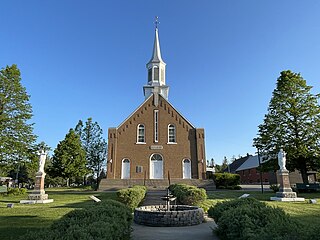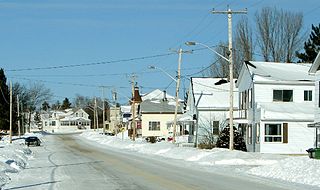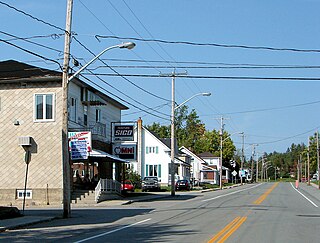
Rouyn-Noranda is a city on Osisko Lake in the Abitibi-Témiscamingue region of Quebec, Canada.

Abitibi Regional County Municipality is a regional county municipality in the Abitibi-Témiscamingue region of Quebec. The seat is Amos.

Témiscamingue is a regional county municipality in the Abitibi-Témiscamingue region of western Quebec, Canada. The county seat is Ville-Marie.

ã

Amos is a town in northwestern Quebec, Canada, on the Harricana River. It is the seat of Abitibi Regional County Municipality.

Ville-Marie is a town on Lake Temiscaming in western Quebec, Canada. It is the largest city and seat of the Témiscamingue Regional County Municipality. As one of the oldest towns in the Abitibi-Témiscamingue region, it is considered the cradle of north-western Quebec and nicknamed "Pearl of Témiscamingue".

La Sarre is a town in northwestern Quebec, Canada, and is the most populous town and seat of the Abitibi-Ouest Regional County Municipality. It is located at the intersection of Routes 111 and 393, on the La Sarre River, a tributary of Lake Abitibi.

Senneterre is a town in the Abitibi-Témiscamingue region of northwestern Quebec, Canada. It is in La Vallée-de-l'Or Regional County Municipality.

Notre-Dame-du-Mont-Carmel in the Mauricie region of the province of Quebec in Canada.

Launay is a township municipality in the Canadian province of Quebec, located in the Abitibi Regional County Municipality.

Saint-Marc-de-Figuery is a parish municipality in the Canadian province of Quebec, located in the Abitibi Regional County Municipality. It is part of the census agglomeration of Amos.

Macamic is a ville in northwestern Quebec, Canada, in the Abitibi-Ouest Regional County Municipality. It covers 202 km² and had a population of 2,744 in the 2021 Canadian census. It is located on the shores of the namesake Lake Macamic.

Authier-Nord is a municipality in northwestern Quebec, Canada, in the Abitibi-Ouest Regional County Municipality. It covers 278.05 km2 (107.36 sq mi) and had a population of 288 as of the 2021 Canadian census.

Chazel is a municipality in northwestern Quebec, Canada, in the Abitibi-Ouest Regional County Municipality. It had a population of 254 in the 2021 Canadian census.

Rapide-Danseur is a municipality in northwestern Quebec, Canada, in the Abitibi-Ouest Regional County Municipality. It covers 173.73 km2 and had a population of 380 as of the 2021 Canadian census.

Clermont is a township municipality in northwestern Quebec, Canada, in Abitibi-Ouest Regional County Municipality. It had a population of 484 in the 2021 Canadian census. The population centre itself is sometimes referred to as Saint-Vital-de-Clermont.

Nédélec is a township municipality in western Quebec, Canada, in the Témiscamingue Regional County Municipality.

Saint-Édouard-de-Fabre is a parish municipality in western Quebec, Canada, in the Témiscamingue Regional County Municipality.

Lac-Despinassy is an unorganized territory in the Canadian province of Quebec, located within the Abitibi Regional County Municipality. The area is east of the municipality of Saint-Dominique-du-Rosaire, north of La Morandière-Rochebaucourt and the parish municipality of Senneterre, and west of the city of Senneterre.

Rivière-Ojima is an unorganized territory in the Abitibi-Témiscamingue region of Quebec, Canada. It consists of two non-contiguous areas in the Abitibi-Ouest Regional County Municipality, separated by the municipality of Authier-Nord. The hamlets of Languedoc and Saint-Eugène-de-Chazel are located within its boundaries.






















